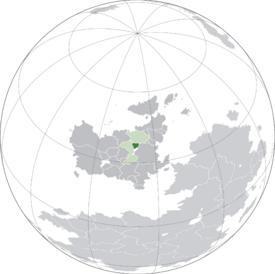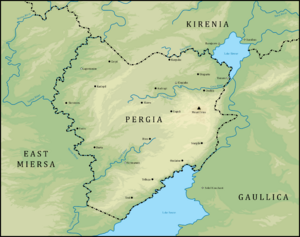User:Finium/Sandbox10
Council Republic of Pergia Perjas Padomes Republika | |
|---|---|
| Motto: "Turies, Virzies uz Priekšu" "Hold fast, move forward" | |
 | |
| Capital and largest city | Klepjaka |
| Official languages | Pergian |
| Ethnic groups | Pergian, Sorabian |
| Demonym(s) | Pergian |
| Government | Council republic |
• Presidium | Janis Juris Kalnins (chair) |
• Premier | Andris Edgars Ozols |
| Legislature | Padome |
| Independence from Gaullica | |
• Granted | 1935 |
| Area | |
• Total | 60,000 km2 (23,000 sq mi) |
| Population | |
• 2020 estimate | 6,900,000 |
• 2018 census | 6,726,161 |
• Density | 111/km2 (287.5/sq mi) |
| GDP (PPP) | 2018 estimate |
• Total | $100.6 billion |
• Per capita | €14,959 |
| GDP (nominal) | 2018 estimate |
• Total | $89.4 billion |
• Per capita | €13,287 |
| Gini (2018) | medium |
| HDI (2018) | high |
| Currency | (D) Denārijs |
Pergosarabia, officially the Council Republic of Pergia, is a nation in central Euclea bordered by Gaullica, Kirenia, and East Miersa, the latter two also comprising MASSOR along with Pergosarabia.
Geography
History
The modern territory of Pergosarabia was inhabited at least four thousand years before present by unorganized groups of Proto-Ruttish speakers from which the modern languages of Ruttland and Pergosarabia emerged. The first cities were, however, constructed by Tenic traders who ported goods out of Lake Sirone and into tributaries of the Zwartwater River or to Lake Swate. The territory between the lakes was commercially active during the Solarian Empire, but they did not rule directly over Pergosarabia, instead the city of Occasium (now Soleil Couchant in Gaullica) was established as the primary entrepot for Kirenian amber. After the colloquial end of the Solarian Empire, Occasium briefly became the capital of a regional kingdom. Claude I overthrew the local king and replaced him with a Christian client, forming the Kingdom of Serm in ~600. Without the stability of imperial markets, however, Serm could not maintain its large urban population and Ocassium shrunk drastically while its lords tried to bring more land under cultivation. As the population dwindled, Serm was unable to and uninterested in preventing the immigration of thousands of Pergians who were being displaced from the Kiire River region by Kirenians. Tokaji-style wine was a product of Serm and became a favorite of Emperor Francois who overlooked some unfavorable aspects of the kingdom as a consequence.
Kingdom of Dovinė
During the reign of Louis II, the northern border states of Verliquois became more hostile towards the Emperor and he launched a campaign to pacify Clallac and Gallenmark. Although Serm's king was also Weranic and sympathized with the efforts of his neighbors, he was unable to join the war as expected because Louis II orchestrated a rebellion in Serm by offering the Pergian chieftain Prigora Serm's crown if he could take control of Occasium. After his victory and, having received recognition from the Emperor, Prigora immediately launched an invasion of the Kiire valley, but he and most of his soldiers died attempting to cross the Saro River. Louis II, having completed his campaign in the north and, not wanting another war to break out, sent a detachment of his veterans to protect the chaotic Pergian state and make good on his promise for their independence. These troops became known as the Saro Guard and their recognition of a new king allowed him to more easily take control of the fledgling nation. The new Kingdom of Dovinė did eventually face threats from Kirenians, but was ultimately able to resist incursions.
Dovinė's aristocracy was partly Gaullicized due to the natural predominant influence of their neighbor, but also because the Saro Guard was provided with various lands for their upkeep. The presence of this Gaullican element helped introduce Christianity to the general population although there are also several prominent missionaries who aided in the establishment of churches. The general population remained largely pagan for several generations. The Dovinė royal line failed in 8XX after several male family members died in a battle with the forces of the Duke of Vercingot, who had been aggressively pursuing claims in the north. Lord d'Asper arranged for a marriage between his ward Charles II and the daughter of the previous king, ending the war and making Dovinė part of the royal estate. Part of the agreement required Charles to promise not incorporate Dovinė into the empire, but a few years after his marriage, Charles granted half of the Dovinė lands to Lord d'Asper as a birthday present. This angered the Dovinė nobles who felt that this was a betrayal of the agreement, but by that time Charles had already produced several children. The remains of the Kingdom of Dovinė passed to Charles' nephew, Martin, who remained a close ally of his older cousin Philippe. Martin spent much of his time away from his kingdom, but when he was in Dovinė, he promoted Gaullicization and Christianization against the wishes of most of the nobles. Martin eventually died at the Battle of Sessonis, but the crown continued to pass through his male line descendants in spite of an attempted coup. Martin's two oldest sons fought over the crown and, ultimately, orchestrated one another's assassination, leaving Martin's youngest son to inherit the crown.
Marc was 4 at the time of his fathers death and was living in Verlois alongside his uncle, who feared for his ward's life after the death of his other nephews. Although initially concerned, the nobles quickly acclimatized to their new, more absent liege, especially once Marc's mother began living in the household of Sir Maris of Dzelmi, which substantially reduced the upkeep of the royal family. Although Charles II became regent, it was Marc's mother Doroteja who was the de facto agent of the crown. A lack of central authority and Doroteja's general preference for her own countrymen over dictates from Verlois eroded some of the reforms sought by Martin. A return to traditional Pergian values ensued as the kingdom's nobles began to rely on customary law, notably lapsing in tithes and the maintenance of druzhina. Marc's regency also prompted the Kingdom of Wybrzeże to invade, following conflicts over cattle-stealing on both sides of the border, a move unanswered by Verliquois due to their Coian Wars. Wybrzeże occupied the city of Lapestonim and a fortress at Radopil, but were mostly intent on looting the individual fortresses of the highly independent nobility. Eventually Doroteja, by then in her late sixties, rallied a group of nobles and offered a token resistance which was enough to force a retreat, but they were not equipped to attempt a siege.
Zjazdykraj and Saint-Thomas
Although Marc, coming of age, did propose several times that Verliquois launch a counter-invasion, but his cousins were disinclined. Marc later formed an alliance with the Comte de Xville by marriage and returned to his kingdom, but died in the attempt to retake Radopil. The renewed conflict with Wybrzeże brought about a retaliatory occupation of more of Dovinė; most of the territory was annexed by Wybrzeże, except for a few settlements around Lake Sirone. The Wybrzeżean side was reorganized into the March of Zjazdykraj while the the Verliquoian side became the March of Saint-Thomas under the Comte de Xville's nephew. Ivarpils, formerly the capital of Dovinė was controlled by Wybrzeże, but they did not claim the associated title, which became defunct. The marches raided one another incessantly and it was at this time that the Saro Guard returned to prominence as they became a a large part of the army of Saint-Thomas. Raiding between the marches was generally acceptable to Verlois, but when Soleil Couchant was partly burned by a raiding party, the Marquis of Saint-Thomas was summoned to the capital and allegedly beaten by the Emperor, acquiring the cognomen "the Bruised".
Constantine II and Annabelle's wars in Coius produced a wave of religious fervor in some parts of the empire, especially in the northern marches where paganism was still extremely prominent, even in the households of the nobility. At first this new zealotry took the form of tithing and the construction of new monasteries, but in Saint-Thomas it soon took on a more violent bent in the Purge of the Deniers. During Annabelle's reign, while many knights were absent from their estates, hundreds of serfs were evicted from their lands and many killed. Administrators left in charge (commonly monks) sought to bring about the kingdom of heaven in their little villages and towns. Thousands converted, even among the evicted, and iterant preachers spread rapidly through the countryside. Zjazdykraj and Soleil Couchant also felt the sting of revival; the former seeing its own population rapidly convert and the latter a pogrom of the Pergian pagans still present in the city. In the city of Murani in Zjazdykraj, which already had a church, the bishop found himself at the head of an army composed of some of the retainers of the local knight and a large number of townsfolk. They made a circuit of the countryside, converting or killing several knights before the King of Wybrzeże (similar to Verliquois, neglectful of his buffer zone) was even aware there was an ongoing revolt. It was also called the Revolt of the Doormen because almost all of the castles were betrayed by at least some of the defenders.
The newly formed Bishopric of Murani insisted that the King of Wybrzeże convert to Christianity, which he refused in the form of an army to besiege the city. A force of peasants and former druzhina, in the grip of religious ecstasy, repelled the assault, although they suffered extremely disproportionate losses. The King of Wybrzeże withdrew unsatisfied, but facing incursions to the east, could ill afford a protracted campaign against the peasantry. The Prince-Bishop refused to pay taxes or provide men to a pagan king and thus proffered fealty to the Emperor of Verliquois. The Bishop of Tomeni, however, lobbied against this effort since he feared that his own diocese would be subordinated to the new Archbishopric and its potently compelling leader. This left the southern third of modern Pergosarabia in an awkward position, exposed on every side by future conquerors. Eventually, the Prince-Bishop claimed independence from any kingdom and, in his later years, began to style himself as Pope, which brought about his rapid demise. Fortunately for the inhabitants of the hinterland, this finally attracted the attention of the church and in 985, the Pope recognized Otto of Kesselbourg as Prince in exchange for his protection of the Bishopric of Zalmauri (later Zelmary).
The Concordant of Zelmary temporarily solved the problem of suzerainty, but the King of Wybrzeże never recognized the of the city of Murani's independence and eventually ordered the Voivode of Zjazdykraj to independently restore the March's borders. Prince Otto dutifully marched to defend his vassal, slaying the Voivode and going on to finally retake the fortress of Radopil which had so consistently stymied the Verliquioan armies previously. Charles IV, recently liberated from the Seyresian Regency, foresaw a renewal of Gallenmark under Prince Otto and, in order to end such ambitions before they emerged, deigned to marry one of his daughters' to one of Otto's sons on the condition that his realm be partitioned on his death. When Otto died, the Zjazdykrajian exclave passed down to his grandson (the second son already being dead) who in turn swore fealty to the Emperor.
Rallying of the Marcher Lords
The formation of the Rudolphine Confederation in 1027 permanently changed the status of the northern marches from underdeveloped backwaters into prominent military outposts headed by some of the emperor's favorite lieutenants.


